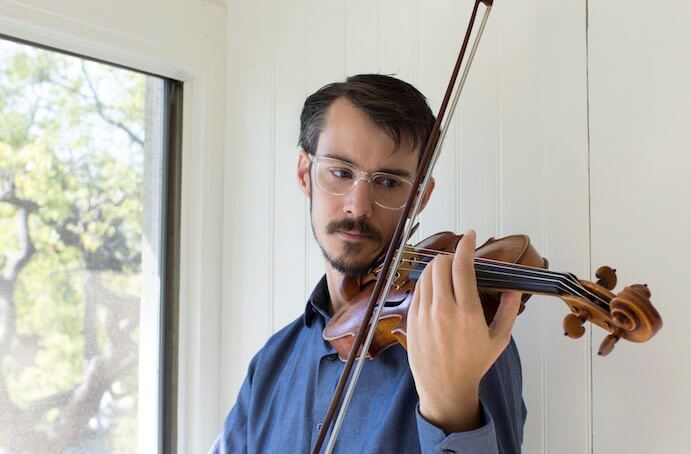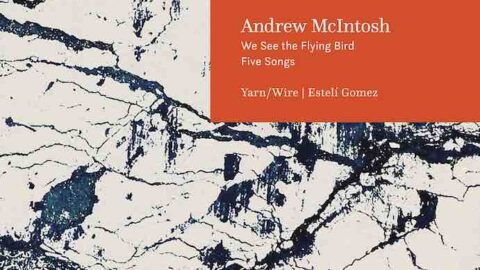In his newest 10” record release from Populist Records, We See the Flying Bird/Five Songs, Andrew McIntosh joins forces with soprano Estelí Gomez (known for her work as a soloist-about-town and as a member of Roomful of Teeth) and members of Yarn/Wire to create an unpredictable and ethereal soundscape. Prior to We See the Flying Bird/Five Songs, McIntosh collaborated with Gomez on a fixed media opera scene from The Industry’s opera, Hopscotch.
The short, powerful works on We See the Flying Bird/Five Songs are a fitting pair. We See the Flying Bird opens simply, with long tones vibrating like drones into dissipation. Short rhythmic fragments begin to punctuate these vibrations, and dissonant tones ring together, the vibrato widening into a quasi-trill as it fades away. Yarn/Wire percussionists Ian Antonio and Russell Greenberg’s sensitive rendering makes each new texture an event of its own. Melodies emerge, tone upon tone overlaps in waves, and then fades away. We See the Flying Bird is in turn both satisfyingly meditative, and aurally demanding.

It is into this soundscape that Estelí Gomez’s glorious soprano emerges with the opening of Five Songs for soprano, percussion, and Fender Rhodes. Gomez’s purity of tone is a perfect match for the vibraphone’s pulsations. She sings–shaping not words, but vowels: white-toned, birdsong-like “ohs” and “ahs”– brightening and darkening her tone, which occasionally expands, crescendoing into shimmery vibrato. In the second song, voice and instruments become unique duet partners, with pianissimo tones framing the mellow cooing of the voice, not exactly in imitation, but as a somewhat mystical echo. The movement ends with a short rhythmic interjection from the singer, a sort-of recitative, or perhaps a vocalise.
The cycle’s third movement opens slowly. First, the vibraphone sounds a single pitch, followed by the singer repeating “ah” on the same pitch, accompanied by the vibraphone. From there, the melody transforms into consonant returning again to a unison pitch. The fourth movement is similar to an expanded exhalation. Gomez gracefully shapes each sustained note, growing and diminishing, bringing her sound to the forefront of the musical fabric, and then retreating back into it. There is power and motion in this movement. Finally, in the last song of the cycle, we hear longer, atonal melodic lines in the voice, falling again into short, repeated gestures, and then, the music stops, just as quickly as it started. McIntosh understands the inherent beauty in these fragments, the most minimal of musical material, layered carefully and stripped back poetically, creating a sound world that is fragile, mutable, and disarmingly attractive.

Less than twenty minutes combined, McIntosh’s We See The Flying Birds and Five Songs make for an ideal programming duo. This 10” vinyl was released in a limited edition of 200 blue and white 45-rpm records, in jackets with artwork by Elizabeth Blumenstock and design by Traci Larson. Each record is hand numbered and features a unique marble pattern in the blue/white vinyl. We See The Flying Birds/Five Songs is available as both a record/vinyl and a digital album from Populist Records on Bandcamp.
























